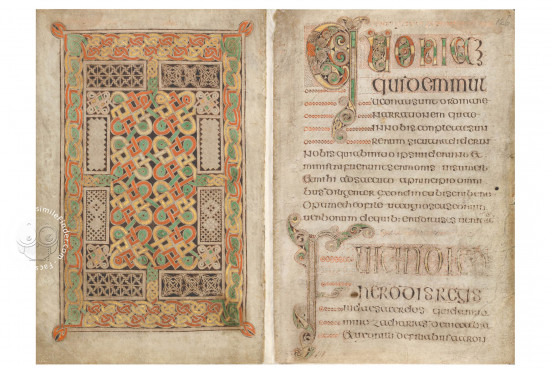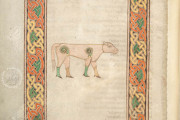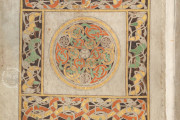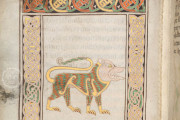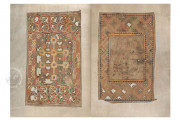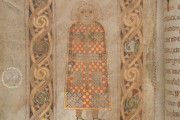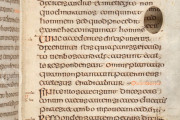A work venerated as a relic of St. Columba, the Book of Durrow is an important manuscript for its incredible artwork and cultural significance. Created in the second half of the seventh century, it is the oldest complete Insular gospel book and provides insight into the development of the Insular style. It is the product of an Irish monastic scriptorium in the northern British Isles, either in Durrow, Iona, or Lindisfarne. The Latin gospel text and prefatory material are written in Insular semi-uncial with significant decorated lettering beginning each section. It was once housed in a silver reliquary case.
In addition to the decorated text, the Book of Durrow also contains eleven full-page illuminations: six interlaced carpet pages and five figural illustrations. A page featuring the four evangelist symbols is placed at the beginning of the manuscript and a page dedicated to individual evangelist symbols precedes its respective Gospel. However, the association of symbol to evangelist follows the pre-Vulgate tradition of St Ireneus: Matthew – Man, Eagle – Mark, Calf – Luke, and Lion – John. Its extraordinary decoration and influence make this manuscript essential in the study of early medieval art.
The Emergence of Insular Style
The Book of Durrow is one of the oldest examples of the Insular style, which would dominate artistic production in the British Isles for the next three centuries. This early work makes clear the fusion of disparate decorative motifs and designs, aspects of which would fuse into the Insular style.
The zoomorphic interlace derives from the Migration period in northern Europe. Spiral motifs have roots in Celtic decoration from the Bronze Age, animal and human forms are drawn from Pictish stone carving and the woven interlace and keys have Mediterranean origins.
Oldest Complete Insular Gospel Book
The Book of Durrow is the oldest complete Insular gospel book to survive. It predates the Lindisfarne Gospels by a generation and only a fragmentary page from a Northumbrian gospel book predates it. While it has been attributed to Colum Cille (Columba) due to a colophon added on fol. 247r, the Irish saint lived a century prior to the manuscript’s date.
However, this connection led to the book’s veneration as a relic. The earliest known metalwork reliquary (cumdach) intended to house a book was also made for the Book of Durrow.
The Broad Influence of Irish Monastic Manuscripts
Placing the origins of the Book of Durrow to a specific place is impossible, but this is due to the spread of Irish monasticism through the northern British Isles. Durrow, Iona, and Lindisfarne are all strong candidates for the book’s production scriptorium because these foundations were linked through shared traditions carried on over centuries.
However, the Book of Durrow was in Durrow Abbey by 916 and remained there until its dissolution in 1540. The book then entered private ownership during which time it suffered water damage when it was used to bless water troughs for livestock.
It came to the ownership of Henry Jones, bishop of Meath, who gave it to Trinity College in the mid-seventeenth century. The shrine and medieval original cover were lost to military occupation in 1688.
Binding description
Binding
The pages of the Book of Durrow are no longer collated in their original folios. Each page has been stitched onto modern parchment for stabilization. The medieval binding was unfortunately lost during an army occupation of Trinity College in 1688, but its theft indicates that it may have been gilded silver perhaps with polished stones. The current binding is half tawed pigskin on boards completed by Roger Powell in 1954.
We have 1 facsimile edition of the manuscript "Book of Durrow": Evangeliorum quattuor Codex Durmachensis facsimile edition, published by Urs Graf, 1960
Request Info / Price
